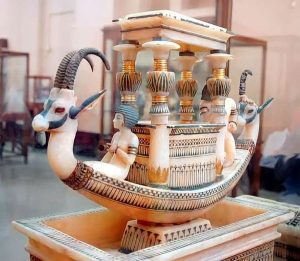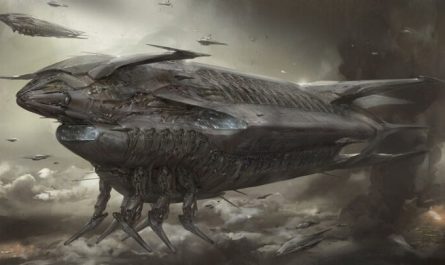Tutankhamun’s alabaster ship is an artifact from ancient Egypt. It’s believed to have been crafted during his reign from approximately 1332–1323 BC. It was discovered in 1922 by British archaeologist Howard Carter during the excavation of Tutankhamun’s tomb (KV62) in the Valley of the Kings, near Luxor. This alabaster boat was found among the many treasures buried with the young pharaoh, intended for his journey in the afterlife. The ship is currently housed in the Egyptian Museum in Cairo.

This alabaster boat is supported by a square pool-shaped foundation. It is regarded one of the most magnificent artefacts in King Tutankhamun’s collection. The purpose of this artefact is unclear, although it was either an unguent bottle or a perfume holder, or it was most likely a centrepiece used for adornment during festivities and rites, as Howard Carter discovered it wrapped in flower garlands.
The piece could have been a receptacle for oil or unguent, but Carter found no residue. He viewed the sculpture as an adornment or a centrepiece, and it is possible that the basin was filled with water to complete the impression of the beautiful centrepiece floating upon the water.
At the stern, a dwarf stands naked, wearing a wig similar to the girl’s. He’s also sporting armbands and wristbands. When this piece was unearthed, he was clutching a pole and most likely served as the helmsman for the alabaster.
The boat’s bow is shaped like an ibex’s head and neck, while the stern is shaped like another ibex facing the same direction. Both animals’ ears were pierced, but the rear figure’s left ear still had an earring. The boat’s hull has an etched and painted pattern that matches the pattern on the base. A collar with gold and coloured glass inlays surrounds the necks of both animals.
The boat’s front features a carved depiction of a seated female. Golden earrings, an armlet, and a bead bracelet are still intact, and her wig is made of grey stone. She has a stained ivory lotus in her left hand. Behind her is a canopy supported by four elegant columns, each with four screen walls, resembling a coffin or lodge.
Both animals’ horns, like the vessel’s ibex-shaped horns, are genuine ibex horns. The ibex on the prow still retains its distinctive beard. The marks and eye details are painted on the bottom of glass or crystal. The front of the support bears the king’s throne name as well as his and his wife’s personal names.


